KAYLA: Come on Zach, I can’t wait to start building our virtual city.
ZACH: Same here Kayla.Let’s begin with a city plan to see if there’s room for everything.
ADA: To work out how much space something will take up, you need to know it’s area.
ZACH: What’s area, Ada?
ADA: Area is the space inside the lines of a 2D shape, look.
KAYLA: So, the pink bits are the areas?
ADA: Precisely.
ADA: Now let’s learn howe to measure area.
KAYLA: Can we start with measuring the area of my house?
ADA: Good idea, that is a simple rectangle so it’s an easy shape to start with.One way you can calculate an area is by counting the squares on the grid.Each square on this grid is one metre by one metre.Or one metre squared.
KAYLA: Okay, so I just count the squares.One, two, three, four, five… forty-eight, forty-nine, fifty.My house is fifty metres squared.Oof! Well that took ages.
ADA: It certainly did.That’s why a quicker way to measure the area of rectangles is by using multiplication.The length multiplied by the width equals the area.
ZACH: Okay, so the length is ten metres and the width is 5 metres.10 x 5 = 50.So the area is fifty metres squared.
KAYLA: Both ways gave us the same answer but that way was much quicker.
ZACH: Now my turn.Let’s find out the area of the basketball court and café.
ADA: Here they are, joined together.This is called a compound or composite shape.So the best way to do this is to split the compound shape into its two separate shapes.
KAYLA: Aah! I see, like this.Now we can work out the area of each and add them together.I understand how we do the rectangle of the basketball court…
ZACH: 30m x 15m = 450 m2.
ADA: That’s right.
KAYLA: How do we calculate the area of the triangle.
ADA: Good question.A triangle is half of a rectangle.
KAYLA: Does this mean we can do the same calculation for a rectangle and divide it by two?
ADA: Yes.
ZACH: 15m x 10m = 150m2.Divided by two equals 75 metres squared.
ADA: The equation for the area of a triangle is height x base √∑ 2.
ZACH: Next up, the park.Hmm.
KAYLA: Well, how are we going to do this?It’s such a random, wobbly shape.
ADA: In maths, we call it an irregular shape.For this one, we don’t need to calculate the exact area, just estimate.
ZACH: Estimate!
ADA: An estimate is a sensible guess. You can use the first method you learnt,counting squares to make an estimate.
KAYLA: Okay, so this grid is in kilometres squared.Awesome, our park is going to be so big.
ADA: Start by counting the full squares.
ZACH: One, two, three, four.
ADA: Very good, and now you can imagine combining parts of squares to make more whole squares.
KAYLA: Okay, that bit and that bit almost make a square.So, five and that little bit and that little bit make a half.Our park is roughly five and a half kilometres squared.
ALL Let’s build it.
In this short animation, Ada introduces Zach and Kayla to the concept of area, and different ways to measure and calculate the area of rectangles, triangles and composite shapes.
The episode starts with counting squares to work out the area of a rectangle, as Kayla tries to work out the area of the house she has designed. The episode then moves on to calculating the area of a rectangle by multiplying the length by the width.
It then covers calculating the area of compound or composite shapes, including working out the area of a triangle, as the children work out the area of the basketball court and café area.
Finally, they learn to use squares to estimate the area of irregular shapes, as they estimate the area of the playground. The children and Ada use both metres and kilometres in their calculations.
This short animated film is from the 91»»±¨ Teach series, Neon City: Measurement and Geometry.
Download/print an A4 activity sheet for this episode (PDF, 328KB). See link below for answers.
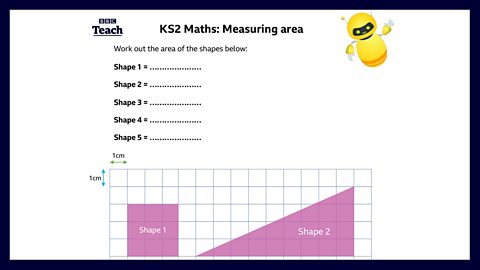
Teacher notes
Before watching
Children could have had some practical experience of calculating the area of a shape by counting the squares within the shape, or using rulers to measure the length and width of a shape.
During the film
Depending on the focus of your lesson, you may want to stop the film at certain points to check for understanding, give pupils a chance to answer the questions at the same time as Zach and Kayla, or develop learning further. You could ask questions such as:
- What does the word area mean?
- What unit is area measured in?
- How would you go about calculating the area of the shape on the screen?
- What do the words length and width mean?
- What does the word estimate mean?
As sentences or calculations are displayed on the screen, you could ask the children to use Kayla and Zach’s model sentences to help them express their reasoning, for example:
- Ada says “The length multiplied by the width equals the area”. Can the children repeat this sentence?
- Zach says “The length of this shape is 10m and the width is 5m. 10 times 5 is 50. The area is 50 metres squared.” Can the pupils use this model sentence to explain their calculations to work out the area of another rectangle?
- Ada says “the equation for working out the area of a triangle is height times base divided by 2.” Give the children a stem sentence to complete to explain how they worked out the area of another triangle, for example:
- The base of this triangle is …m and the height is …m. This is …m². Divided by two, this is …m². The area of the triangle is …m².
After watching
You could provide pupils with a number of examples of shapes for them to work out the area.
You could provide the children with opportunities to use their reasoning and problem solving skills by, for example, giving them the area of a shape and asking them to work out what the length and width of the shape might be. You could pose problems such as “Always, Sometimes, Never: The area of a rectangle is an odd number” and ask the children to use mathematical language to explain their answer.
(PDF, 690KB)
Curriculum notes
This short film is suitable for teaching maths at KS2 in England and Northern Ireland, 2nd Level in Scotland and Progression steps 2 and 3 in Wales.
More from Neon City: Measurement and Geometry
Perimeter. video
Zach and Kayla are creating windows for their virtual house design and Ada explains how they can work out the perimeter for the windows they want.
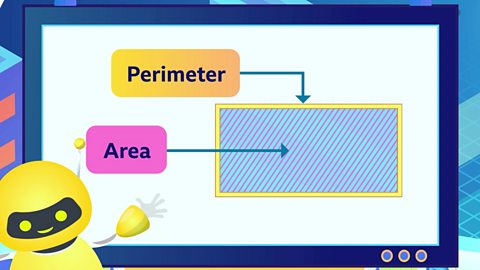
Volume. video
Kayla and Zach decide to build a swimming pool for their virtual city and Ada explains how to calculate the volume and capacity of a cuboid shape.

Metric and imperial measurements. video
Kayla and Zach decide to build a new hovertrain system from the city to the beach, but they get confused between kilometres and miles. Ada explains how to calculate betwen the two measurement systems, metric and imperial.

Measuring angles - Part 1. video
Kayla and Zach are designing ramps for the skatepark and Ada explains that designing ramps requires us to measure angles – the amount of turn between two lines.
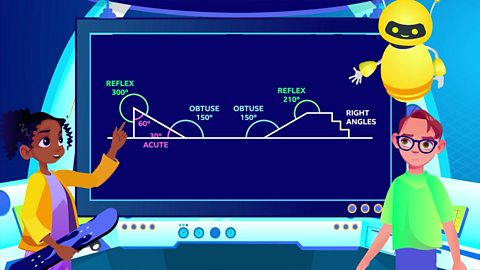
Measuring angles - Part 2. video
Whilst adding ramps to their virtual skatepark, Zach and Kayla progress from measuring angles to calculating angles on a straight line and full turn.

Missing lengths and angles. video
A computer virus has corrupted the Neon City software. Zach and Kayla must answer four questions within three minutes, or their city will be erased.

Regular and irregular polygons. video
Zach’s design for a pond in the virtual city park leads to Ada explaining the properties of regular and irregular polygons.
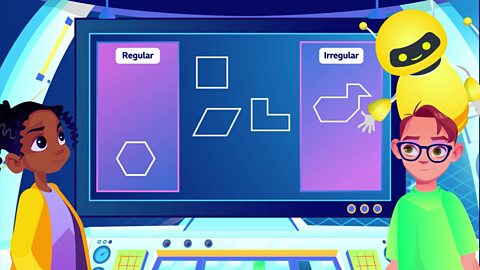
Coordinates on a grid. video
Kayla and Zach are designing a fairground and need to plot where to place the different rides, so Ada teaches them about the x-axis and y-axis on a coordinate grid.
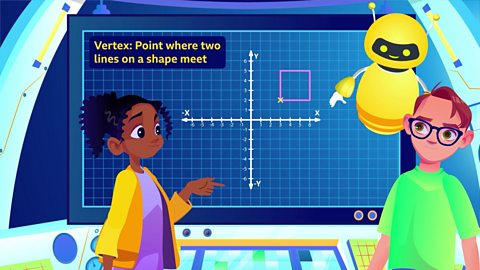
Units of time. video
Ada asks Kayla and Zach a series of quiz questions, requiring them to convert from one time measurement unit to another.
